India
Gangarati
Arati is a tradition Hindu devotional song sung to one's guru or chosen form of god or goddess. Naturally sitting on the banks of the Ganges, arati to the goddess as the river Ganges is performed every night on the Triveni Ghat, a set of step leading to a sandy beach. One of the highlights of this arati, as well as in Haridwar, is that little boats of candles are floated on the river, making a beautiful effect. A lot of people come down for arati, including a portion of the local sadhu population.
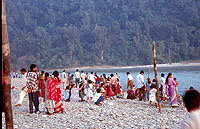 While standing and waiting for the
ceremony to begin, with 6 pujarists
holding huge ghee candle "trees", I begin
to get really mesmerized by this river,
like it has a hold on me. It is really
wide, at least a half mile or more across,
and really swift flowing. A white water
raft goes by working with the bifg current.
After a while, I hear,"Hello sir, how are
you!" thinking that it's either another
tout or someone trying their English
on me. It turns out to be this lonely
young Indian boy who has just been sent
to Rishikesh, of all places to go to
a computer school and this is his first
week of school. So we get into a whole
discussin in broken English about computers
while the aratie ceremony is being setup,
with candle, christmas lights, flowers,
etc. He asks me how much I make and I tell
him approximately my salary. He asks
rupees? and I so no, US dollars, and he
turns a bit pale at the sum. It seems
I make the same amount in dollars as
what his father, a goverment worker, makes
in rupees. Which means I make 42 times as
much as his dad. I hope this inspires
him to finish computer school.
While standing and waiting for the
ceremony to begin, with 6 pujarists
holding huge ghee candle "trees", I begin
to get really mesmerized by this river,
like it has a hold on me. It is really
wide, at least a half mile or more across,
and really swift flowing. A white water
raft goes by working with the bifg current.
After a while, I hear,"Hello sir, how are
you!" thinking that it's either another
tout or someone trying their English
on me. It turns out to be this lonely
young Indian boy who has just been sent
to Rishikesh, of all places to go to
a computer school and this is his first
week of school. So we get into a whole
discussin in broken English about computers
while the aratie ceremony is being setup,
with candle, christmas lights, flowers,
etc. He asks me how much I make and I tell
him approximately my salary. He asks
rupees? and I so no, US dollars, and he
turns a bit pale at the sum. It seems
I make the same amount in dollars as
what his father, a goverment worker, makes
in rupees. Which means I make 42 times as
much as his dad. I hope this inspires
him to finish computer school.
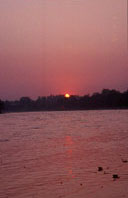 This unusual break from the spiritual scene
over, I go back to watching the arati setup
and the Gange river. As the time for arati
approaches, I begin to feel the power of
the river, not its water power, but its
spiritual presence - it becomes absolutely
clear to me that this is a goddess and water
is feminine - it is like having a visionless
vision, I can feel the presence of the
goddess ever stronger, and I'm ready to
start crying again. It was almost like she
showed up for arati. I felt a little like
Carlos Castenada, in the first book, when
Don Juan tells him to meditate on the river,
and he is so taken by the river goddess that
he ends up somewhere else and Don Juan has
to save him. I was caught up in the power
of the river, but didn't go anywhere physically.
Arati starts, and it begins with the traditional
tune that I am familiar with, then several
other devotional songs. The six pujarists
swing their brass candle trees holding
up to 20 candles. The brass holder get so hot
a man comes by to pour water on the candle
holder arms, so the pujarist is not scorched.
The crowd of several hundred join in singing
and when the last song is sung, the crowd
goes into the water to get their feet wet.
We all then partake in taking some sweet prasad
and candle light, placing our hand over the
light and then to the third eye.
This unusual break from the spiritual scene
over, I go back to watching the arati setup
and the Gange river. As the time for arati
approaches, I begin to feel the power of
the river, not its water power, but its
spiritual presence - it becomes absolutely
clear to me that this is a goddess and water
is feminine - it is like having a visionless
vision, I can feel the presence of the
goddess ever stronger, and I'm ready to
start crying again. It was almost like she
showed up for arati. I felt a little like
Carlos Castenada, in the first book, when
Don Juan tells him to meditate on the river,
and he is so taken by the river goddess that
he ends up somewhere else and Don Juan has
to save him. I was caught up in the power
of the river, but didn't go anywhere physically.
Arati starts, and it begins with the traditional
tune that I am familiar with, then several
other devotional songs. The six pujarists
swing their brass candle trees holding
up to 20 candles. The brass holder get so hot
a man comes by to pour water on the candle
holder arms, so the pujarist is not scorched.
The crowd of several hundred join in singing
and when the last song is sung, the crowd
goes into the water to get their feet wet.
We all then partake in taking some sweet prasad
and candle light, placing our hand over the
light and then to the third eye.
Walking back, I am very blissed out over the event, particularly the feeling-sense appearance of the goddess Ganges. It seems the forces of nature are still strong here, not beaten down by cities, suburbs and condos, being left in somewhat of its original untarnished state, and this may add to the force that pervades Rishikesh. After a nice meal at Neelams, it's home to write this and for another excursion on the morrow.
The Incredible Nilkanth Temple
The hotel Ganga Kinares, like most higher quality hotels in India, has a travel service desk, where you can book all sorts of trips such, from trekking, white water rafting and general travel. I know that by using them, I am paying more money than if I used one of the scores of travel services around Rishikesh, but on this trip I can pay for the extra convenience.
So I meet Beehm, the travel agent in charge of this hotel and the hotel Mandakini down the road. He is a short, athletic Nepalese fellow who speaks excellent English. He is a registered mountaineer and guide for Himalayan trekking, and he seems to be very competent at his job. I make it clear to him that I am not interested in white water rafting, and more into a spiritual pilgrimmage and mountain adventure, which is also very common.
So he sets me up with a one day tour of two of the more important temples in the surrounding Rishikesh area, the Nilkanth ("Blue Throat") temple, and the Kunjapuri mountaintop Durga temple, which sits on an almost perfect conical peak about 2500 ft (that a WAG, or Wild Ass Guess) above Rishikesh, and you can see it from town.
Beehm arranges a taxi for me for the trip. I can see this is a higher quality taxi than the ordinary, it's exceptionally clean and well maintained, inside and out. Almost all taxis in India are diesel Ambassadors, and look like a 1960s version of a Volvo sedan. They can handle a whole lot of punishment on the dubious roads of India, particularly in the mountains. My driver is "Kuku", who really seems to handle his car like a pro (more him later).
Nilkanth is a Shiva temple in the mountains east of Rishikesh. Nil-kanth means "blue throat" and apparently, this spot is where Lord Shiva swallowed poison, which got stuck in his throat which then turned blue. It goes through a thick forest that borders on a wild animal preserve. Walking to Nlkanth, which is a tough trek uphill, can lead to sights of wild elephants, monkeys, and other assorted creatures. However, it is told to stay very clear of the wild elephants, known as 'hati' in Hindi. They leave you alone, but if you tease them or bother them (what that constitutes wasn't told to me!), they will attack, and if they catch you, they hold you down with one foot, and rip you limb from limb using their trunk. Ouch. Several kujas (Hindi for "gypsies" or wandering forest folks) were killed this year.
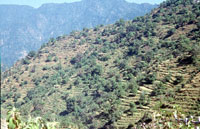 So Kuku and I take off to Nilkanth on the
mountain "road". I quote it because the term
is being used quite loosely - remember those
Jeep Cherokee commercial where the Jeep
goes bouncing through the bump dirt road and
then goes splashing in the stream? That's
the road to Nilkanth.
So Kuku and I take off to Nilkanth on the
mountain "road". I quote it because the term
is being used quite loosely - remember those
Jeep Cherokee commercial where the Jeep
goes bouncing through the bump dirt road and
then goes splashing in the stream? That's
the road to Nilkanth.
The windy road passes through several small villages and on the way, we pass numerous groups (packs? gaggles? posses?) of monkeys, which are of two types, the more common brownish/red monkey, where the males have those giant red "balls", and another type called "Langul", which are white with black faces - they remind me of old hindi men, which makes me wonder if bad Hindus get reincarnated as these Languls. (No disrepect at all, but some pictures of Ramana Maharshi and Shirdi Sai Baba have a 'monkeyish' look to them).
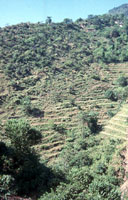 This road has recently been built - the
only way to Nilkanth previously was the
aforementioned walking path with the
pissy elephants. It is all dirt and in
about the first third of the 1.5 hour
journey, I am car sick, which is a common
occurance for the next few days. I start
thinking,"oh shit, finally ate the bad
food, here comes the diarrhea and vomiting."
But when we stop occasionally, I am instantly
better. Aha! But when things get a little
rough, the gods of Pepto Bismol come to
mu rescue (very important item for a trip
to India for a number of uses).
This road has recently been built - the
only way to Nilkanth previously was the
aforementioned walking path with the
pissy elephants. It is all dirt and in
about the first third of the 1.5 hour
journey, I am car sick, which is a common
occurance for the next few days. I start
thinking,"oh shit, finally ate the bad
food, here comes the diarrhea and vomiting."
But when we stop occasionally, I am instantly
better. Aha! But when things get a little
rough, the gods of Pepto Bismol come to
mu rescue (very important item for a trip
to India for a number of uses).
The Himalayan valleys are very narrow and extremely steep, like 65-70 degree steep, and we have to travel long distances just to get to the other side of the numerous valleys. Just like I've seen in many Asian photographs, the use of "terrace" farming is common, where the hillside is cut away to create large flat areas - they look like green staircases for giants. But they are beautiful and make wonderful pictures. However, I am bouncing around in the back the Ambassador, and a picture is really difficult. Fortunately, Beehm gave me a quick Hindi lesson before the trip, writing down essential words in my little notebook. So I say, "ruko Kuku, kripiya" (stop Ruko, please) and he accommodates when possible. But since this is essentially a one land dirt road, he has to pull off at the edge of a curve, which has extra space. He is incredibly adept at working the curves and dealing with oncoming buses and other taxis, and I do mean oncoming! After a while, I stop being concerned at all for the next possible head on collision or tumble down the 1000 foot cliff.
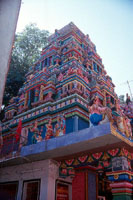 Finally the temple can be seen in the
midst of a tiny village near the top
of the mountain. This village is
centered around the temple and apparently
is in existence only to serve the temple.
There are numerous concrete staircases
leading all over the place and several
streams run through town. Kuku drops me
off, points me in a general direction,
and promptly walks off into the woods.
Finally the temple can be seen in the
midst of a tiny village near the top
of the mountain. This village is
centered around the temple and apparently
is in existence only to serve the temple.
There are numerous concrete staircases
leading all over the place and several
streams run through town. Kuku drops me
off, points me in a general direction,
and promptly walks off into the woods.
So here I am in this confusing maze of staircases. Oh, there are plenty of signs, but they're all in Devanagari script. Real helpful to me, but then this _is_ a Hindu holy site, just recently opened up to a larger portion of the world (there is one bus per day to this temple). So dumb American guy goes walking up some staircase only to find himself in the ladies bathroom area. Ooops.
Finally I can see the way to the temple grounds, and approach the large tile facility, common to many temples, that are used to wash both hands and feet prior to entrance. Now, when you think temple (at least I do) you may think of a reasonable sized building that is capable of holding many people, and there are certainly many temples like this. But this is a mountainside temple, and like the Char Dham temples, it is small, about 12 foot square, with an inner chamber about 6 foot square.
Having done a decade or more of Hindu style spiritual practices and rituals, I am used to the various rituals, such as pujas, aratis, chanting, etc, but nevertheless I am feeling a bit raw. I get in line to the inner chamber, and the force of this place hits me like a slap in the face, more like a slap in the whole body. Omigod! Usually upon entering a place, shakti takes a bit of time to penetrate the bodily koshas (or sheaths), especially after a bouncy car ride. But not this place.
I notice that there are stands outside the temple grounds selling what looks like puja plates, containing flowers, incense, prasad candies, water, colorful imitation flower malas, etc. And peeking into the inner chamber, I see that the local priest, a swami, is allowing people to do their own pujas. This seems like a rare and uncommon occurance, probably because of the inaccessibility of the place. Kuku suddenly appears behind me, all smiles, and I feel a reassured.
So I go out to a stand a purchase a puja plate, and then return in line. I cannot even describe the potency of this place - it makes all of the other places I've been to pale in comparison. I'm only two feet or so from the inner chamber and I can see the statue of a cobra, about 2 foot high, as the central icon of this site. People are pouring milk and water over the hooded cobra icon, and the priest dips the flowers and prasad in the basin formed by the curled snake body, and gives them back to the person doing the puja.
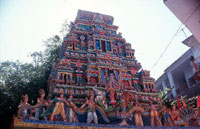 But that is minimal to my experience -
it is the intensity of this place
that is so overwhelming I feel like
I want to scream - sometimes the
force of shakti can build a strong
pressure in the body. A woman in
front of me is saying the famous
Shiva mantra "Om Namah Shivay(a)",
and everytime she says it, a wave
of force penetrates my body as if
the mantra has particular potency
in this place. Again, the power
of this place is surprising, but
this is unlike the other places I've
been to. It is a particular form
of 'shakti' associated with Shiva that
marks this place, what I can only
say as the force of pure presence -
there is no movement in my body -
I am not going up, it's not blissful
in the way you would think, but is
is absolutely and positively the
most concentrated locus of spiritual
force I've experienced in a long,
long time (more on this later) - this
chamber is only 6 foot square.
But that is minimal to my experience -
it is the intensity of this place
that is so overwhelming I feel like
I want to scream - sometimes the
force of shakti can build a strong
pressure in the body. A woman in
front of me is saying the famous
Shiva mantra "Om Namah Shivay(a)",
and everytime she says it, a wave
of force penetrates my body as if
the mantra has particular potency
in this place. Again, the power
of this place is surprising, but
this is unlike the other places I've
been to. It is a particular form
of 'shakti' associated with Shiva that
marks this place, what I can only
say as the force of pure presence -
there is no movement in my body -
I am not going up, it's not blissful
in the way you would think, but is
is absolutely and positively the
most concentrated locus of spiritual
force I've experienced in a long,
long time (more on this later) - this
chamber is only 6 foot square.
After a few minutes the area in front of the icon opens and I sit to do a puja, pouring water over the hooded cobra while saying Om Namah Shivaya. He takes the incense and flowers from me, dips the flowers in the water and returns them to me. I make a small offering of a few rupees, also a common practice, used for maintenance of the site. When I am done, I park myself in a small corner of the chamber to sit and watch others come in, and to meditate in this place. A woman brings in her little boy, who can just barely walk, and he stands in front of the icon and he is blissful and giggly. People talk in the chamber, something I am not used to, but it doesn't diminish the transmission of this place.
After a while I stand and watch from the back entrance of the chamber. I am very moved - THIS is what I came to India to find, a place like this, and it's only been a week. I thought perhaps Tirumvanamalai, where Ramana Maharshi's ashram is, would offer some presence of this Shivalike signature, but this place here is the real deal, particularly in its concentrated potency. I've been interested in mostly Shiva temples for a reason, so let me explain in as few a words as possible...
 Back |
 Rishikesh, con't. |
|
|
Page 12. |
||
